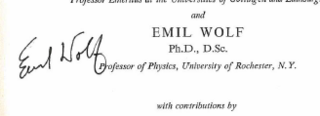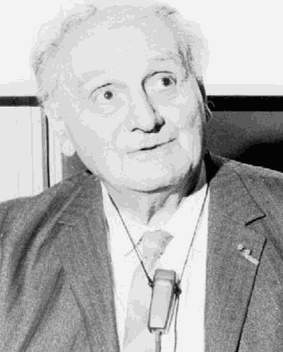
Optics is the branch of physics that studies the behaviour and properties of light, including its interactions with matter and the construction of instruments that use or detect it. Optics usually describes the behaviour of visible, ultraviolet, and infrared light. Light is a type of electromagnetic radiation, and other forms of electromagnetic radiation such as X-rays, microwaves, and radio waves exhibit similar properties.
A photon is an elementary particle that is a quantum of the electromagnetic field, including electromagnetic radiation such as light and radio waves, and the force carrier for the electromagnetic force. Photons are massless particles that always move at the speed of light when in vacuum. The photon belongs to the class of boson particles.

Max Born was a German-British physicist and mathematician who was instrumental in the development of quantum mechanics. He also made contributions to solid-state physics and optics and supervised the work of a number of notable physicists in the 1920s and 1930s. Born was awarded the 1954 Nobel Prize in Physics for his "fundamental research in quantum mechanics, especially in the statistical interpretation of the wave function".
In physics, coherence expresses the potential for two waves to interfere. Two monochromatic beams from a single source always interfere. Physical sources are not strictly monochromatic: they may be partly coherent. Beams from different sources are mutually incoherent.

In optics, any optical instrument or system – a microscope, telescope, or camera – has a principal limit to its resolution due to the physics of diffraction. An optical instrument is said to be diffraction-limited if it has reached this limit of resolution performance. Other factors may affect an optical system's performance, such as lens imperfections or aberrations, but these are caused by errors in the manufacture or calculation of a lens, whereas the diffraction limit is the maximum resolution possible for a theoretically perfect, or ideal, optical system.

Emil Wolf was a Czech-born American physicist who made advancements in physical optics, including diffraction, coherence properties of optical fields, spectroscopy of partially coherent radiation, and the theory of direct scattering and inverse scattering. He was also the author of numerous other contributions to optics.
In optics, the Fraunhofer diffraction equation is used to model the diffraction of waves when plane waves are incident on a diffracting object, and the diffraction pattern is viewed at a sufficiently long distance from the object, and also when it is viewed at the focal plane of an imaging lens. In contrast, the diffraction pattern created near the diffracting object and is given by the Fresnel diffraction equation.
In electromagnetism, the Clausius–Mossotti relation, named for O. F. Mossotti and Rudolf Clausius, expresses the dielectric constant of a material in terms of the atomic polarizability, α, of the material's constituent atoms and/or molecules, or a homogeneous mixture thereof. It is equivalent to the Lorentz–Lorenz equation, which relates the refractive index of a substance to its polarizability. It may be expressed as:

In physics, the wavefront of a time-varying wave field is the set (locus) of all points having the same phase. The term is generally meaningful only for fields that, at each point, vary sinusoidally in time with a single temporal frequency.

Paul Karl Ludwig Drude was a German physicist specializing in optics. He wrote a fundamental textbook integrating optics with James Clerk Maxwell's theories of electromagnetism.

Electron optics is a mathematical framework for the calculation of electron trajectories in the presence of electromagnetic fields. The term optics is used because magnetic and electrostatic lenses act upon a charged particle beam similarly to optical lenses upon a light beam.

In optics, a ray is an idealized geometrical model of light or other electromagnetic radiation, obtained by choosing a curve that is perpendicular to the wavefronts of the actual light, and that points in the direction of energy flow. Rays are used to model the propagation of light through an optical system, by dividing the real light field up into discrete rays that can be computationally propagated through the system by the techniques of ray tracing. This allows even very complex optical systems to be analyzed mathematically or simulated by computer. Ray tracing uses approximate solutions to Maxwell's equations that are valid as long as the light waves propagate through and around objects whose dimensions are much greater than the light's wavelength. Ray optics or geometrical optics does not describe phenomena such as diffraction, which require wave optics theory. Some wave phenomena such as interference can be modeled in limited circumstances by adding phase to the ray model.
In physics, ray tracing is a method for calculating the path of waves or particles through a system with regions of varying propagation velocity, absorption characteristics, and reflecting surfaces. Under these circumstances, wavefronts may bend, change direction, or reflect off surfaces, complicating analysis. Strictly speaking Ray tracing is when analytic solutions to the ray's trajectories are solved; however Ray tracing is often confused with ray-marching which numerically solves problems by repeatedly advancing idealized narrow beams called rays through the medium by discrete amounts. Simple problems can be analyzed by propagating a few rays using simple mathematics. More detailed analysis can be performed by using a computer to propagate many rays.

In radiometry, spectral radiance or specific intensity is the radiance of a surface per unit frequency or wavelength, depending on whether the spectrum is taken as a function of frequency or of wavelength. The SI unit of spectral radiance in frequency is the watt per steradian per square metre per hertz and that of spectral radiance in wavelength is the watt per steradian per square metre per metre —commonly the watt per steradian per square metre per nanometre. The microflick is also used to measure spectral radiance in some fields.
The Helmholtz reciprocity principle describes how a ray of light and its reverse ray encounter matched optical adventures, such as reflections, refractions, and absorptions in a passive medium, or at an interface. It does not apply to moving, non-linear, or magnetic media.

Pierre-Michel Duffieux (1891–1976) was a French physicist, known as the founder of Fourier optics.

Hamilton's optico-mechanical analogy is a conceptual parallel between trajectories in classical mechanics and wavefronts in optics, introduced by William Rowan Hamilton around 1831. It may be viewed as linking Huygens' principle of optics with Maupertuis' principle of mechanics.

For light and other electromagnetic radiation, the plane of polarization is the plane spanned by the direction of propagation and either the electric vector or the magnetic vector, depending on the convention. It can be defined for polarized light, remains fixed in space for linearly-polarized light, and undergoes axial rotation for circularly-polarized light.
In optics the Smith–Helmholtz invariant is an invariant quantity for paraxial beams propagating through an optical system. Given an object at height and an axial ray passing through the same axial position as the object with angle , the invariant is defined by












